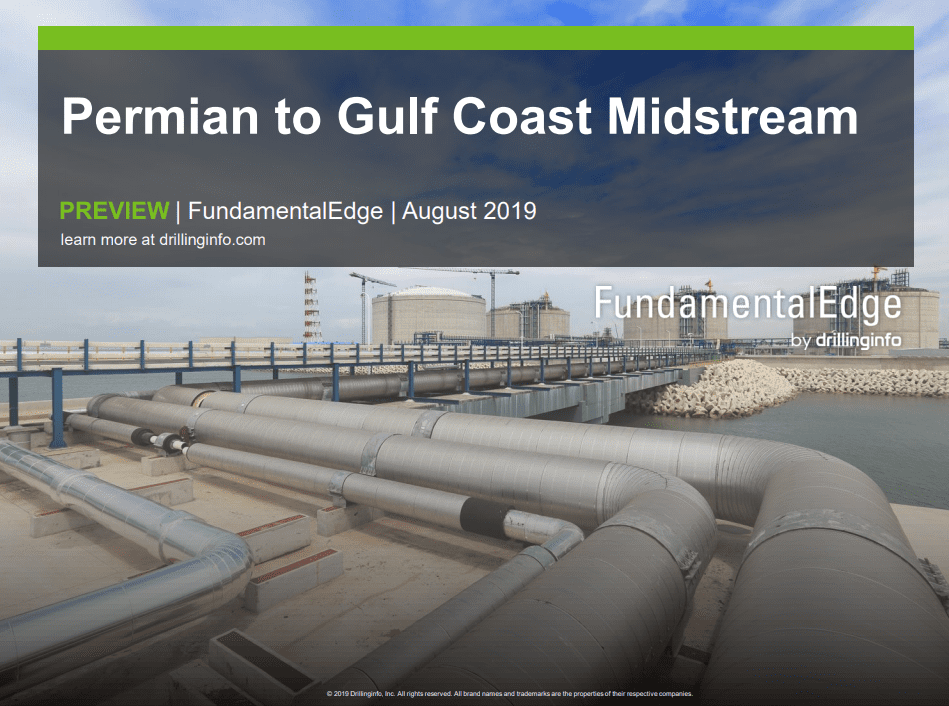Austin, TX – Drillinginfo, the leading energy SaaS and data analytics company, has released Permian to Gulf Coast Midstream, the latest installment of their FundamentalEdge series, which presents an overview of oil, gas, and natural gas liquids (NGL) infrastructure currently proposed between the Permian basin and Gulf Coast export terminal locations.
Underscoring the lack of adequate takeaway capacity in 2018-2019, plus the expected importance of coastal oil, natural gas, and NGL exports, in this report Drillinginfo highlights the expected impact of upcoming long-haul takeaway capacity projects and the price differentials they’ll create.
“The Permian basin has experienced unprecedented production growth and remains the world’s focus, from producer to private equity, to service and supply companies,” said Bernadette Johnson, Vice President of Strategic Analytics at Drillinginfo. “But the Permian continues to be challenged by existing pipeline constraints and the inability to efficiently and effectively move oil, natural gas, and NGLs to the market. All hydrocarbons are tied at the drill bit and one affects the other. Although many players in the Permian are targeting crude oil primarily, natural gas processing and pipeline bottlenecks can have a negative impact on that crude oil production. However, a light at the end of the tunnel may soon be visible – at least for those that can hang in there through 2020,” said Johnson.
In Permian to Gulf Coast Midstream, Drillinginfo analyzes numerous planned pipeline projects and the bottlenecks they expect will be cleared providing relief to America’s most prolific, but congested basin.
Key Takeaways from the Report:
- Production growth in the Permian basin is testing the limits of existing midstream and downstream infrastructure, requiring further capital investment in long-haul pipelines, gas processing plants, NGL fractionators, and coastal export terminals.
- Crude oil production continues to rise in the Permian basin despite economic headwinds resulting from sub-$60/bbl WTI prices. Nevertheless, the pace of growth is at risk of slowing significantly if the low flat-price environment persists. With additional long-haul pipeline capacity coming online in the second half of 2019, noncommitted shippers will likely find themselves squeezed out as spot arbs shut. As volumes are further increased to the Gulf Coast (and away from Cushing), additional export capacity will be required, and there is an acute need for new export facilities capable of fully loading VLCCs. A race to the finish has begun, with numerous onshore and at least seven offshore terminals currently proposed or in development.
- Although natural gas production is mostly a by-product of drilling for crude in the Permian basin, flaring is just not a long-term option. In DI’s high case scenario, dry gas production could increase by 50% (~5 Bcf/d) over the next five years.
- Market participants are also facing weak regional pricing, with Waha basis trading at levels more than $1.00/MMBtu under Henry Hub. Hence, at least five projects are currently proposed to alleviate this constraint. All projects will be transporting the gas east toward South Texas and Louisiana to feed LNG exports as well as growing power and industrial demand.
NGL production out of the Permian is expected to continue to grow, with most of the production destined for the Gulf Coast. To allow for the extra production, a number of pipeline projects are under construction or in planning to transport the NGLs. As NGLs arrive at the Gulf Coast, they are then fractionated. Fractionation capacity has been running tight since mid-2018, resulting in numerous fractionation projects along the coast. The fractionation bottleneck was relieved slightly in early 2019, when two projects hit the market. However, with most projects scheduled to come online in early 2020 and after, it is possible the bottleneck will reappear in late 2019 and early 2020.
